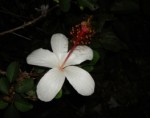Scientific Name: Hibiscus arnotiianus
Endemic: O’ahu
Description: Unreal shrubs or small trees up to 20 ft. tall or more, but usually stay in the 6-8 foot range. These plants have dark green foliage, which is more glabrous than most species of native white hibiscus. The most attractive feature of this plant is its beautiful white and also fragrant flowers which emerge at the tips of branches. In the morning, the flowers open up and are a brilliant white and by the end of two days they slowly fade to a light pink and begin to close up before falling off. The petals of this hibiscus are very robust and thick which enable it to stay open for so long and which also adds to it’s stronger than normal fragrance. The stem tips of this variety is also dark maroon which makes the plant attractive even when not in bloom.
Distribution: This exceedingly rare native white hibiscus is endemic to the mesic forests of O’ahu in both the Ko’olau and Wai’anae mtn. ranges
Landscape Use: As with most hibiscuses, the pualoalo can be trimmed into a beautiful, highly colorful hedge or left alone to be admired as a specimen plant. It is very wind, sun and drought tolerant and is resistant to the unattractive bumps from gall mites that seem to plague most hybrid hibiscus. This is yet another perfect native plant for any garden. Hint: plant this plant in front of a dark background like a rock wall or ti hedge to really show off the flowers! Watch out for aphids and whitefly, if you do notice them treat the plant by either shooting them off with a water hose or spraying them with pesticide. If you follow the directions on the bottle you should have good results.
Cultural Uses: The flowers of Hibiscus were eaten as a laxative and some sources say that the native red hibiscus were eaten by girls and women while the white hibiscus were eaten by boys and men. In addition the flowers were also strung into lei but today it is most often put behind the ear.
Pualoalo

